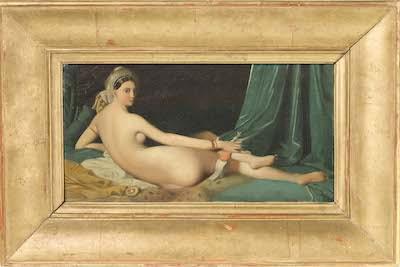Executed in 1814, Jean-Auguste-Dominique Ingres’s Grande Odalisque at the Louvre has long been recognized as a landmark not only in the oeuvre of the artist but also in the development of the reclining nude as a topic of European art, a theme that stretches from antique models to Titian and Goya and later to Manet, Matisse, and Picasso.
Commissioned as early as 1808 by Caroline Murat, Queen of Naples, the painting was sent to Naples in 1815, but remained undelivered. Following the fall of Napoleon, Joachim Murat had been executed and Caroline went into exile. Ingres’s painting was shown at the 1819 Paris Salon, where it was not well received. A critic remarked that there was “in that figure no bones, no muscles, no blood, no life, no relief, nothing in a word that indicates it is done from nature,” adding that the artist had done so on purpose with the intent of doing badly. Indeed, the nude figure was not based on reality, but had come straight from the painter’s imagination.
 Jean-Auguste-Dominique Ingres, Odalisque, c. 1825–35, gift of the 2014 Collectors Committee, photo © 2014 Museum Associates/LACMA
Jean-Auguste-Dominique Ingres, Odalisque, c. 1825–35, gift of the 2014 Collectors Committee, photo © 2014 Museum Associates/LACMA
The painting acquired a particular significance in the eyes of the artist, attested by the numerous variants and versions in different sizes he executed during the next twenty years. In 1820, Ingres wrote in an inventory of his works that he had executed “several small repetitions” of his large Odalisque, of which several are known.
In classical painting, small-size works are often studies toward lager compositions—not so with Ingres, who reversed the creative process. There are in fact very few if any complete “sketches” by Ingres for his large compositions, for which he made instead numerous drawings and oil studies of details.
It is also well-known that Ingres often repeated his compositions. He wrote for instance: “It has sometimes been brought to my attention, and perhaps accurately, that I have represented my compositions too often, instead of making new works. Here is my reason: most of these works, which I love because of the subject matter, seemed to me worth improving by repeating them, or touching them up . . .” Among his works, three in particular were the object of such repetitions: his self-portrait, the Virgin with the Host, and this Odalisque.
If Ingres repeated his compositions, he never copied them. The variations on his self-portrait or on the Virgin with the Host show significant differences with one another. Such is the case also with the Odalisque. In this version for instance, Ingres reintroduced elements from the original version but now only visible through technical analysis. The precision of the drawing in this version may have been obtained through an optical device—a “camera lucida”—as suggested by David Hockney in his study on the artist’s drawings. The model, however, would not have been in that case an actual figure but instead another painting. This is but one of the many fascinating elements of that small and rare painting that allows us to penetrate into the mind of one of the greatest painters of the 19th century.
Acquired as part of the 29th-annual Collectors Committee, which took place over the weekend, the painting will be on view in the near future in the Bolker Gallery in the Ahmanson Building.
J. Patrice Marandel, The Robert H. Ahmanson Chief Curator of European Art



